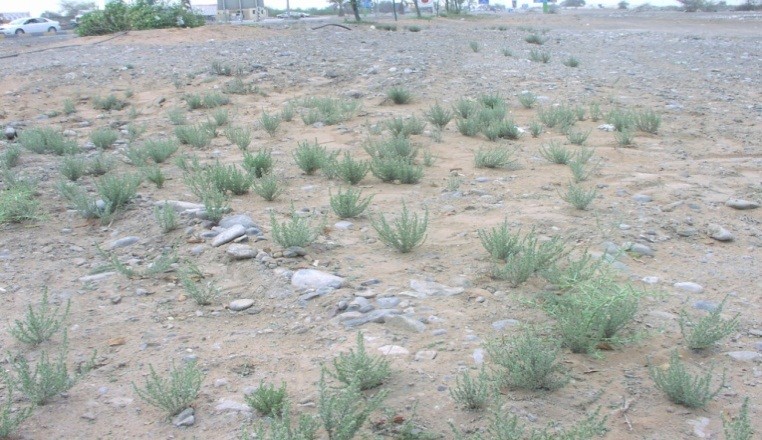
Cressa cretica / مليحة
Cressa loscosii Tremols Cressa villosa Hoffmanns & Link
Shuwayl, Nedewa, Balig, Abu Hasabah, Malah, Maleeh, Ghararh, Naaeem, Maleekh, Selmas.
Rudravanti, Littoral bind weed
Maleehah
Convolvulaceae

Aerial parts
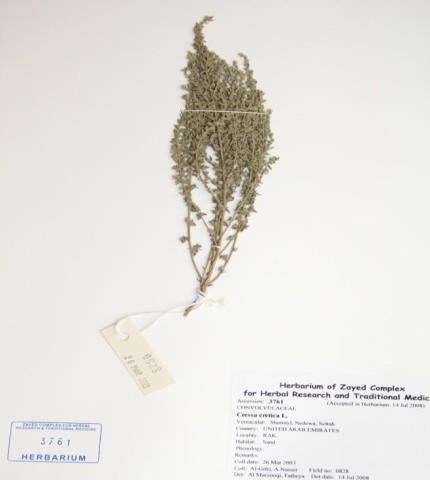
Herbarium specimen
Ethnobotanical Characteristics
Description
Ascending or decumbent, rarely prostrate shrublet, many-branched from the base with stems more or less white-woolly and villous, to 60 cm high. Leaves linear-oblong to lanceolate, appressed-pubescent, the lateral nerves usually distinct and depressed and the margins sometimes somewhat repand-wavy, the lowest long-tapering to a petiole and obtuse, 8 cm long, 2 cm wide, becoming shorter lanceolate elliptical, sessile and acute above. Flowers clustered several together, but usually opening singly, on peduncles somewhat shorter than or exceeding the subtending leaf. Sepals lanceolate-acuminate, white-villous, 5-9 mm long; corolla rather showy, 15-20 mm long, hardly lobed, pink or sometimes nearly white; ovary white-villous at apex (Mandaville ,1990).
Habitat and Distribution
Stable sands, perhaps most commonly in coastal areas, but also inland on somewhat silty ground. Tolerant of disturbed ground and sometimes on roadsides. Very common along Abu Dhabi – Ras Al Khaima littoral on raised sand and low dunes inland of sabkha; also, in plantations further east and north, always in sand. (Mandaville, 1990; Western, 1989).
Part(s) Used
whole plant
Traditional and Medicinal Uses
Plants are used as a tonic, stomachic, aphrodisiac, alterative and expectorant, and locally used for camel fodder (Fawzy Kotb, 1985). Boiled in water and taken internally as a tonic, aphrodisiac and expectorant. Dried leaves crushed with sugar taken as a treatment for jaundice. (Jongbloed, 2003, Ghazanfar, 1994).
Pharmacognosy and Phytochemistry
Plant material studied
Dried leaf
General appearance
The leaf is grayish green in colour، small in size (about 4 mm long and 1.5 mm broad at the broadest part), non-petiolate، lanceolate، tomentose (pubescent) within covering trichomes on leaf surfaces and along the margins، tender، unbreakable.
Microscopical characteristics
he surface view of the leaf shows that it is densely covered with covering trichomes and that it has an intricate type of vascular network. A transverse section of the leaf shows its isobilateral character where two layers of palisade tissues are found beneath the upper epidermis and other two palisade layers are above the lower epidermis. Each epidermis consists of small oval cells that protrude outward into small arches or half circles. They are covered with a variety of covering trichomes including conical tapering or T-shaped types. Short glandular trichomes with oval to rounded beads are also observed. The palisade cells are short and closely packed and they occupy most of the mesophyll zone. The spongy mesophyll consists of a few layers of small rounded cells and they surround the closely packed vascular tissues whose vessels are annularly thickened.
Plant material Studied
Dried stem and branches
General appearance
The dried stem and branches are light brown to violet in colour. Hay has pubescent touch. The branches are almost cylindrical in outline and its out part is usually partially removed, exhibiting a light brown part with prominent longitudinal ridges. It is tender and not easily broken. The plant shows much branching.
Microscopic characteristics
The stem is almost circular in outline in cross-section. The epidermal layers consist of small oval cells surrounded by thick striated cuticle. The epidermal cells protrude outwards into small arches. The epidermis bears numerous tapering conical trichomes of different sizes with occasional T-shaped covering trichomes. Short glandular trichomes with rounded to oval heads are also detected. The epidermis is underlain by few layers of yellow anticlinal rod-shaped cortical parenchyma cells that surround a circle of one layer of unlignified fibers that have thick cell walls and narrow lumens. These layers of fibers are separated from the vascular tissues by few layers of light yellow distorted small cortical parenchyma cells. The heavily lignified vascular tissues occupy a large zone and they form a continuous circle with annularly thickened vessels. The pith occupies a very wide central zone whose cells adjacent to the vascular tissues are small and distorted while those at the center are larger and they are polygonal or rounded in shape with comparatively thick walls.
Powdered plant material
The material consists of the pounded aerial parts. It is a dark yellowish-green coarse, gritty, heterogeneous, somewhat fine powder with some comparatively larger fragments. It has a pleasant slightly spicy to straw-like odour and a salty taste. Microscopically، the powder shows numerous covering trichomes of various types and different lengths but they are mostly long conical, tapering, or broad T-shaped ones. The majority are detached from tissues, while glandular trichomes with oval to rounded heads are normally attached. The powder also shows many green fragments of the leaves at different orientations, exhibiting the characteristics observed in the fresh sample. Also shown are stem fragments of dark brown bark cells with their observable thick cell walls and also long compact vascular tissues with their narrow vessels and fibers.
Parts studied
leaf and stem
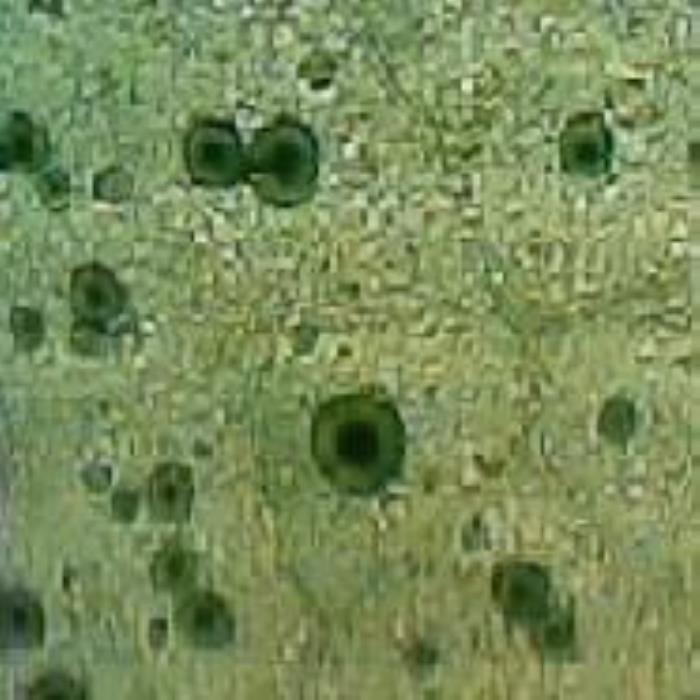
A) Surface view of leaf
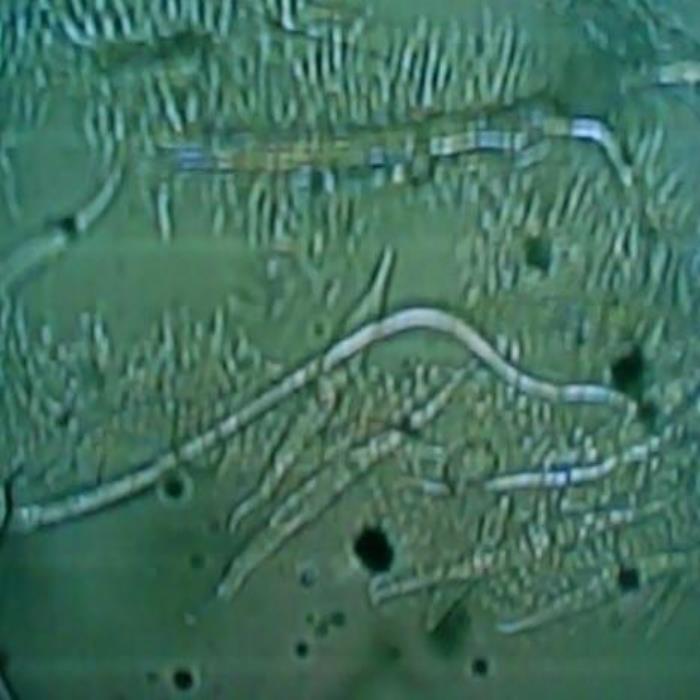
B) TS of leaf

C) TS of stem
- A. A surface view of the leaf at the lower epidermis showing the intricate type of vascular network and some cluster crystals of calcium oxalate.
- B. TS of the leaf at the lower epidermis showing long conical trichomes and T-shaped trichomes.
- C. TS of the stem showing the different layers with the pith at the center.
Chemical constituents
The isolation of syringaresinol-β-D-glucoside from Cressa cretica was reported. Coumarins، sterols quercetin and coumaranochromone glycoside (Shahat, 2004). Alkaloids, flavonoids, tannins، sterols and/or triterpenes and coumarins were present in the aerial parts (Al-Yahya, 1990). Also, Shahat (2005) identified the presence of five flavonoids; Quercetin; quercetin-3-β-O-D-glucoside; kaempferol-3-O-β-D-glucoside; kaempferol-3-O-α-L-rhamno-(1-+6)- β-D-glucoside; quercetin-3-O-α-L-rhamno-(1+6)-β-D –glucoside (rutin) in the aerial parts of Cressa cretica. A quercetin glycoside was detected by Rastogi (1991). Β-sitosterol, its glucoside, n-octacosanol، umbelliferone, scopoletin, isopimpinellin and quercetin were isolated (Shahina, 1994; Rastogi, 1998).
The following chemical studies have been carried out on the aerial part of the plant Cressa cretica (Quality Control methods, 1998; Evans, 1996) (ZCHRTM unpublished work):
Physicochemical Constants
Loss of weight on drying at 105°C: 8.60
Absolute alcohol solubility: 3.20
Water solubility: 14.40
Successive extractives (%)
Petroleum ether (60-80) °C : 2.20
Chloroform : 1.70
Absolute alcohol : 15.70
Ash values (%)
Total ash : 23.70
Water soluble ash : 14.10
Acid insoluble ash (10% HCl) : 0.80
pH values (aqueous solution)
pH of 1% solution : 6.816
pH of 10% solution : 5.577
Elemental analyses
Ash values (British Herbal Pharmacopeia -Reference)
Assay and identification of element (AOAC international Reference)
|
Apparatus |
(AA-6800 Shimadzu-Flame method) |
||||
|
Element |
Std. conc. µg/ml(ppm) |
Sample conc.mg/ml |
Samples absorbance |
Actualconc.mg/ml |
Actual conc.(%) |
|
Cr |
1،2،4 |
20.002 |
0.003 |
0.02155 |
0.002155 |
|
Zn |
0.5،1،2 |
20.002 |
0.2484 |
0.1190350 |
0.0119035 |
|
Cu |
0.5،1،2 |
20.002 |
0.0366 |
0.01746 |
0.001746 |
|
Fe |
1،2،4 |
20.002 |
0.7358 |
1.410505 |
0.1410505 |
|
K |
1،2،4 |
20.002 |
1.8931 |
1.071255 |
0.1071255 |
|
Pb |
1،2،4 |
20.002 |
0.000 |
0.000 |
0.000 |
|
Cd |
0.25،0.5،1 |
20.002 |
0.0002 |
0.000035 |
0.000035 |
UV Spectral studies
|
Ultraviolet Spectrum (USP reference) |
||||
|
Apparatus |
Milton Roy Spectronic Genesys 5 Spectrophotometer - Milton Roy. |
|||
|
Sample conc. (mg / ml) |
Solvent |
λ max (nm) |
λ min (nm) |
Abs.( λ max - λ min) |
|
0.98 |
Intestinal Fluid simulated without pancreatic pH=7.50.1 |
277 |
265 |
0.605 – 0.576 |
|
1.014 |
Gastric Fluid simulated without pepsin pH =1.20.1 |
292 322 |
268 307 |
0.872 - 0.783 0.890 – 0.723 |
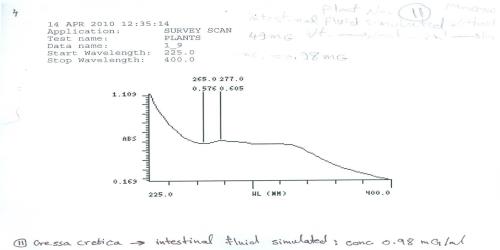
Intestinal Fluid simulated without pancreatic
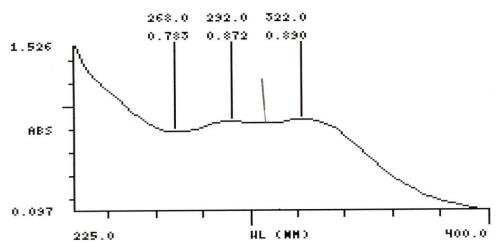
Gastric fluid simulated without pepsin
Chromatographic Studies
Thin layer chromatography (Wagner and Bladt, 1996)
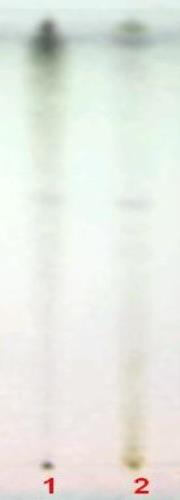
A
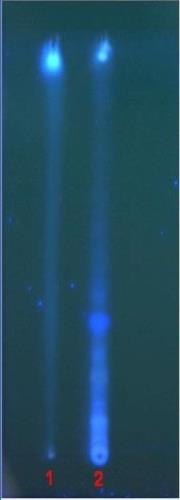
B
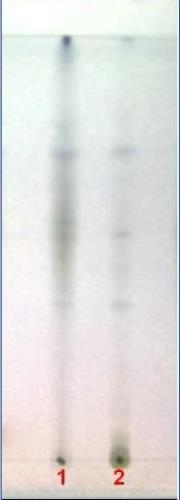
C
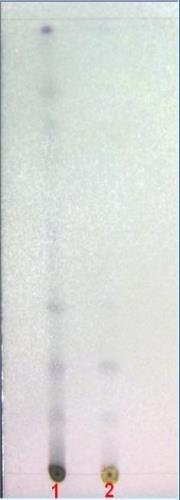
D
TLC fingerprint of Petroleum ether 60-80oC (track 1) and Methanol extract (track 2)
|
Mobile phase Fig. |
A&B |
: |
Ethyl acetate, methanol, water (100:13.5:10) |
|
|
C |
: |
Toluene, ethyl formate, formic acid (5:4:1) |
|
|
D |
: |
Toluene, ethyl acetate (93:7) |
|
Detection |
B |
: |
UV 366nm |
|
Derivatization |
A, C&D |
: |
Vanillin-Sulphuric acid-vis |
Pharmacological and toxicological Studies
Cressa cretica ethanolic extract produced contraction of the isolated guinea-pig ileum, which was inhibited by the atropine treatment. However، the chloroform extract did not elicit any response of the muscle. Both ethanolic and chloroform extracts antagonized the effect of acetylcholine on frog’s rectus abdominis muscle to the same degree. The contraction of the isolated diaphragm of rat induced by electrical stimulation of phrenic nerve was also inhibited almost completely in the dose of 4 mg of ethanolic extract; the effect of chloroform extract was found less than the ethanolic extract quantitatively. The stimulation of sciatic nerve with 3V stimulus produced a significant contraction of gastrocnemius muscle. However, these contractions were found to gradually decrease on successive stimuli after the addition of a single dose of 2 mg of ethanolic extract or chloroform extract. These results suggest that both the ethanolic and chloroform extract possess significant neuromuscular blocking activity (Tariq, 1984). Cressa cretica plant was shown to have a weight reducing effect in animals (Palit, 1999). Both ethanolic and chloroform did not have a significant on isolated rabbit heart. However, a reduction in the blood pressure of anaesthetized rabbit by both the extracts was observed (Mossa, 1985). The decrease in the blood pressure was blocked by atropine.
The biochemical and hematological studies showed no significant changes in serum glucose, cholesterol, and electrolytes levels. No appreciable changes were observed in RBC and WBC counts, hemoglobin levels, prothrombin time and fibrinogen levels.
The following pharmacological and safety evaluation studies were carried out using the aqueous extract of the plant Cressa cretica at ZCHRTM Labs. (Derelanko 2002; Han, 2003):
|
ACTIVITY |
RESULTS |
|||
|
Strong |
Moderate |
Mild |
Negative |
|
|
Analgesic / writhing test |
√ |
|
|
|
|
Antidepressant |
|
|
|
√ |
|
Anticonvulsant |
|
|
√ |
|
|
Anti-inflammatory |
√ |
|
|
|
|
Gastrointestinal activity |
|
|
|
√ |
|
Effect on rabbit jejunum |
|
√ |
|
|
|
Effect on rat fundus |
|
|
|
√ |
|
Effect on Guinea pig ileum |
|
|
√ |
|
| Effect on Guinea pig tracheal chain | √ | |||
|
Effect on right rat atria |
√ |
|
|
|
|
Antithrombotic effect |
|
|
√ |
|
|
Studies on biochemical parameters |
√ |
|
|
|
|
Studies on hematological (RBC،HGB &HCT) ↑ |
|
√ |
|
|
|
Motor co-ordination (grip strength & motor activity |
|
|
|
√ |
|
Rectal temperature |
|
|
|
√ |
|
Body weight |
|
|
|
√ |
|
Vital organs |
|
|
|
√ |
|
Mortality |
|
|
|
√ |
Summary of the results
The plant extract produced a moderate inhibition of the isolated rabbit jejunum, indicating that the plant extract possesses pharmacological activity against diarrhea (Antidiarrheal activity/ antispasmodic activity/ spasmolytic activity). However, it showed mild anti-convulsion activity and a significant positive inotropic effect on rat atria in vitro. Positive inotropic agents increase myocardial contractility and are used to support cardiac function by increasing the strength of muscular contraction (Cardio tonic / cardioprotective effect/ myocardial stimulant) that have a tonic effect on the heart. The plant extract decreased prothrombin time when compared to the control.
No Broncho-dilatory effects were found on a histamine- induced tracheal chain of the Guinea pig. The plant extract did not show anti-nociceptive activity and also devoid of antidepressant-like effect. The plant extract tested on ear edema method for five days treatment did not show significant anti-inflammatory activity.
The LD50 of aqueous extract of plant was found to be higher than 10g/kg b.wt. when administered once via gastric intubation in mice. (LD50=>5g/kg،p.o.). Repeated dose toxicity studies at the rate of 1 g/kg, p.o. /day was conducted for 15 days. No death was recorded from day 1 to day 10 of the observation period. Following the plant extract administration at the dose of 0.5 g/kg, 1 g/kg b.wt., daily for 15 days (per os.); serum BUN، CREA، TP، ALB and AST were found significantly decreased, whereas LDH, ALT and TBIL remained unchanged. No significant change was found in any other parameters studied, as compared to the control group.
In the hematology studies, the plant increased the blood RBCs, HGBs, HCTs and decreased the WBCs, while the other hematological parameters remained normal.

Effect on serum parameters
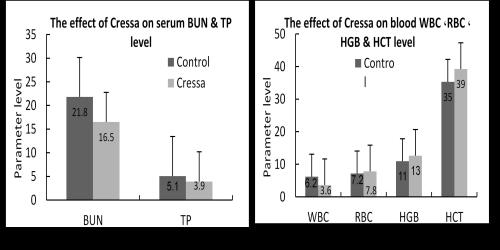
Effect on hematological parameters
Antimicrobial activity
The aqueous extract of the whole plant was tested against Mycobacterium smegmatis, C. tropicalis, different strains of Methicillin Resistant Staphylococcus aureus, different strains of ESBL-producing K. pneumonia, E. coli, Pseudomonas aeruginosa and showed weak anti- Mycobacterium smegmatis activity.
References
- A.A. Shahat، N.S. Abdel-Azim، L. Pieters، A.J. Vlietinck. Isolation and NMR spectra of syringaresinol-β-D-glucoside from Cressa cretica. Fitoterapia 75 (2004) 771– 773.
- Al- Yahya MA، Al- Meshal IA، Mossa JS، Al- Badr AA، Tariq M. Saudi Plants: A Phytochemical and Biological Approach. king abdulaziz city for science and technology ،1990.p.140.
- El-Ghonemy، A. A. (1993). Encyclopedia of Medicinal plants of the United Emirates. 1st Edition. University of U.A.E.
- Fawzi، M. K. (1995). Weeds in the United Arab Emirates. University of U.A.E.
- Jonbloed، M. V.، Feulner، G. R.، Boer، B. & Western، A. R. (2003). The comprehensive Guide to the Wild Flowers of the United Arab Emirates، Erwda، Abu Dhabi، U.A.E.
- Mandaville، J. P. (1990). Flora of Eastern Saudi Arabia. Kegan Paul International، Riyadh، Saudi Arabia.
- Miller، A. G. and M. Morris . 1988. Plants of Dhofar، The Southern Region of Oman. Traditional Economic and Medicinal Uses. Diwan of Royal Court Sultanate of Oman—Holmes MC Dougall، Edinburgh، Scotland.
- Mossa، J.S.، Al Yahiya، M.A.، Tariq، M; and Al-Meshal، I.A. (1985) Phytochemical and Pharmacological investigations of some Saudi plants showing hypotensive activity. 4th South East Asian/Western Pacefic Regional Meeting of Pharmacologist، Penang، Malaysia، May 1985.
- Palit P، Furman BL، Gray AI. Novel weight-reducing activity of Galega officinalis in mice. J Pharm Pharmacol. 1999، 51، 1313-9.
- Rastogi & Mehrotra، Compendium of Indian medicinal plants: vol. 2، PID، New Delhi،1991، p.217.
- Rastogi & Mehrotra، Compendium of Indian medicinal plants: vol. 5، PID، New Delhi،1998، p.254.
- Shahat، Adbelaaty A.; Nazif، Naglaa M.; Abdel Azim، Nahla S.; Pieters، Luc; Vlietinck، Arnold J. Flavonoids From Cressa Cretica. Qatar University science journal - 25(2005)، p. 72-77
- Shahina A. GhazanfarHandbook of Arabian Medicinal Plants. CRC Press.
- Shahina A. Ghazanfar، . (1994). Handbook of Arabian medicinal plants. CRC Press; 1 edition (1994).p.88
- Tariq، M. Al Yahya، M.A.; Al-Meshal، I.A. and Mossa، J.S. (1984) Studies on Saudi plants causing neuromuscular blockade. Proc. 9th Int. Cong. Pharmacol. (IUPHAR)، London.
- Western، A. R. (1986). The Flora of United Arab Emirates. An introduction. -Al Ain.
- Western، A. R. (1989). The Flora of United Arab Emirates. An introduction. Publications of the U.A.E. University.
